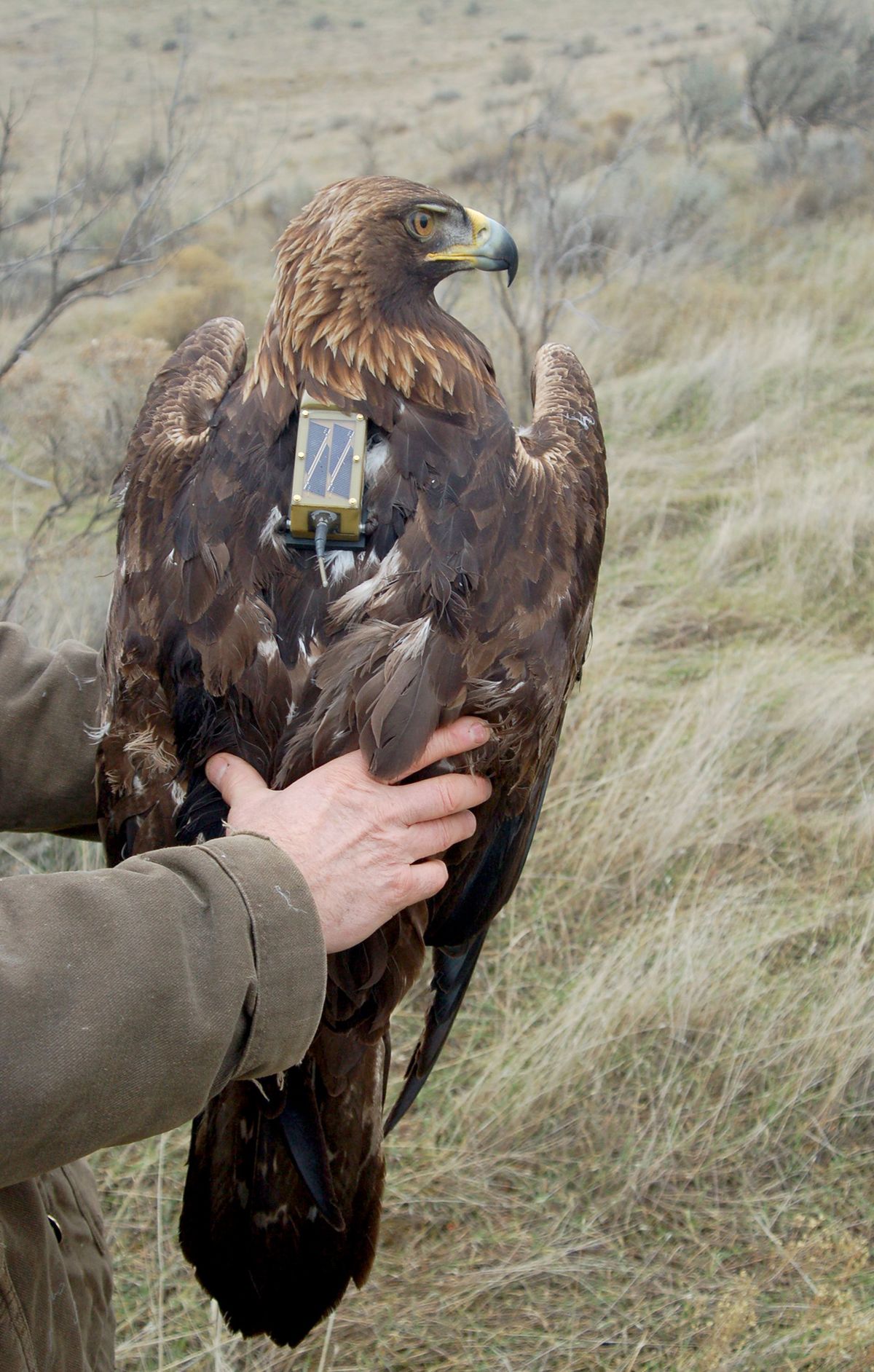A few special birds lend a wing in golden eagle preservation

Golden eagles – including one that wore a “backpack” for eight years – are carrying their weight in research that could help curb their gradual decline.
Data from an Eastern Washington study launched in 2004 may be helpful in positioning wind farms, identifying lead poisoning sources and pinpointing critical habitats.
The bird’s susceptibility to collisions with rotating wind turbine blades has generated concern by the U.S. Fish and Wildlife for golden eagles across the country.
About half of the Washington study birds have elevated levels of lead, enhancing the golden’s candidacy for endangered species protections.
With the help of technology that’s blossomed in that last 10 years, Washington Fish and Wildlife raptor specialist Jim Watson said the study report he’s publishing will be one of the most significant documents in his career.
Watson, 56, trapped his first raptor 43 years ago as a middle school student helping with a university wildlife study. Hundreds of research birds later, adult golden eagles stand out as the hardest to capture, he said.
But more than 20 eagles have been lured by bait to a net that’s deployed remotely. Before they’re released, each of the birds is fitted with a $4,000 satellite transmitter.
“It weighs 70 grams and looks like a little kid’s backpack,” Watson said. “Teflon ribbon straps that go over its shoulders and under its wings are sutured together at the breast bone.”
One study bird is a standout: No. 33240, which packed a transmitter for eight years. That’s twice as long as most study birds are followed before the bird is lost, the transmitter conks out or the bird pulls out of the harness.
“The bottom line is that these modern techniques allow us to study the bird and not interfere with the natural cycle of things,” Watson said. “All the researchers have a personal interest in the birds and their well-being.”
While wearing the harness, 33240 continued to nest with its mate and reproduce, providing the study a tremendous amount of information.
Washington has three populations of golden eagles during the year:
• Migratory birds working through the state;
• Wintering birds from the north;
• Non-migratory birds that are breeding or nesting at this latitude.
The study will help define the home range of these local breeding birds and the habitat they use.
A home range runs 6 to 8 miles from the nest during the year, Watson said.
“Most of the birds are staying in the area year-round,” he said. “But after breeding, they tend to stray from their territory for 100 to 200 miles for a few weeks and float around.
“That’s minor in the world of raptor movements. The eagles in Alaska are totally migratory, with movements south through Mexico.
“It’s all about food: where the prey is.”
Washington historically has had about 280 golden eagle nesting territories occupied by pairs. Today Watson estimates about 120 pairs and only 60-80 are nesting and producing young in a year.
Golden eagles average one surviving chick from two-three eggs.
In Eastern Washington, they’ve been seen taking a wide range of prey, including coyote pups, deer fawns, yellow-bellied marmots, game birds – especially chukar partridge – and a variety of small mammals.
Some eagle hunts can be dramatic.
“Goldens weigh 9 to 12 pounds, but they can lift 2 to 3 pounds off a level surface,” Watson said. “And they have ways of taking bigger game. When they know a mountain goat or bighorn lamb is on a cliff, they’ll fly at an angle and knock it off, letting it fall to its death or holding on and gliding to the ground.”
In the big picture, however, the decline of jack rabbits, ground squirrels and shrub-steppe habitat may have had the biggest cumulative impact on the eagles, Watson said.
Nestlings are fed only what a parent can carry back to the nest, since eagles, unlike vultures, don’t regurgitate food.
Juvenile eagles are vulnerable to predators such as great horned owls. They’re most vulnerable to wild cats and coyotes when they’re learning to fly.
Adult goldens tend to soar above the dangers of predation, but they’re vulnerable to a wide range of human-caused deaths, especially electrocution from power lines.
Watson’s research will shed light on how the eagles use terrain.
The latest transmitters allow satellite GPS information to be downloaded into his cell phone.
“I can get a bird’s location every 15 seconds as well as its altitude,” he said. “With GIS modeling, we can overlay the information on terrain maps and see what kind of habitat it’s using.”
The study is showing how goldens select hunting areas where they can get lift from surface currents or thermals.
“These are big birds,” he said. “In calm air they don’t fly until 10 or 11 a.m., waiting for lift.
Of about 20 golden eagles involved in the study, five are still wearing active transmitters. At least three have been poached. One was killed in a trap and several birds have had injuries from traps. One was killed by another eagle. Six are listed as “status unknown” or awaiting necropsy results.
And No. 33240 has special “retired” status. After eight years of service it was recaptured, perhaps only because its mate was lured by the bait.
The cooperative golden eagle was at least 13 years old with a life expectancy in the wild of no more than about 20.
Watson removed the eight years of weight from its shoulders, and released it to live out its life backpack free.
Contact Rich Landers at (509) 459-5508 or email richl@spokesman.com.